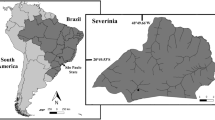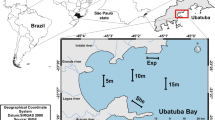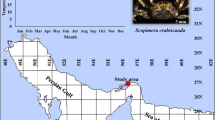Abstract
In 2006 an unusual find of Procambarus clarkii, today considered one of the most dangerous exotic crayfish, was made within the preserved brackish Mediterranean biotope “Palude di Torre Flavia” (Rome, Italy). Here the investigation on the population structure and dynamics of P. clarkii inhabiting this brackish wetland is presented in an attempt to describe the life history pattern in this type of habitat. The present study showed that this species has a lower growth rate and higher longevity than other studied European P. clarkii populations, and that it can damage brackish habitats and human livelihoods. The main results of this study chiefly concern the differences found between several life-history parameters of the studied population and those obtained in previous studies. These results showed the high ecological plasticity of P. clarkii, indicate the need to intervene before the species spreads further in brackish water, for the conservation of Mediterranean coastal habitats.






Similar content being viewed by others
References
Anastácio PM, Marques JC (1995) Population biology and production of the red swamp crayfish Procambarus clarkii (Girard) in the lower Mondego river valley, Portugal. J Crustac Biol 15:156–168. doi:10.2307/1549018
Anastácio PM, Correia AM, Menino JP (2005a) Processes and patterns of plant destruction by crayfish: effects of crayfish size and developmental stages of rice. Arch Hydrobiol 162:37–51. doi:10.1127/0003-9136/2005/0162-0037
Anastácio PM, Parente VS, Correia AM (2005b) Crayfish effects on seeds and seedlings: identification and quantification of damage. Freshw Biol 50:697–704. doi:10.1111/j.1365-2427.2005.01343.x
Barbaresi S, Tricarico E, Gherardi F (2004) Factors inducing the intense burrowing activity by the red swamp crayfish, Procambarus clarkii, an invasive species. Naturwissenschaften 91:342–345. doi:10.1007/s00114-004-0533-9
Beverton RJH, Holt SJ (1964) Tables of yield functions for fishery management. FAQ Fisheries Technical Paper
Blake MA (1995) The vulnerability of juvenile signal crayfish to perch and eel predation. Freshw Biol 33:233–244. doi:10.1111/j.1365-2427.1995.tb01164.x
Chiesa S, Scalici M, Gibertini G (2006) Occurrence of allochthonous freshwater crayfishes in Latium (Central Italy). Bull Fr Peche Piscic 380–381:883–902. doi:10.1051/kmae:2006029
Chiesa S, Celauro D, Scalici M, Monaco A, Scalisi M, Gibertini G (2008) Il gambero rosso della Louisiana Procambarus clarkii nella Riserva Naturale Regionale “Lago di Posta Fibreno”: problematiche di gestione e priorità di azione per il futuro. Atti della prima giornata di studio “Tutela e conservazione dell’ecosistema acquatico Lago di Posta Fibreno area SIC/ZPS IT6050015”, Università degli Studi “La Sapienza”, Orto Botanico, pp 100–118
Costa AC, Correia AM, Rodrigues ML (1996) Monitoring a population of Procambarus clarkii in São Miguel (Azores, Portugal). Freshw Crayfish 11:203–212
Covich AP, Palmer MA, Crowl TA (1999) The role of benthic invertebrate species in freshwater ecosystems. Bioscience 49:119–127. doi:10.2307/1313537
Diéguez-Uribeondo J, Söderhäll K (1993) Procambarus clarkii Girard as a vector for the crayfish plague fungus, Aphanomyces astaci Schikora. Aquac Fish Manag 24:761–765
Dörr AJM, La Porta G, Pedicillo G, Lorenzoni M (2006) Biology of Procambarus clarkii (Girard, 1852) in Lake Trasimeno. Bull Fr Peche Piscic 380–381:1155–1170. doi:10.1051/kmae:2006018
Fidalgo MRA, Carvalho P, Santos P (2001) Population dynamics of the red swamp crayfish, Procambarus clarkii (Girard, 1852) from the Averio Region, Portugal (Decapoda, Cambaridae). Crustaceana 74:369–375. doi:10.1163/156854001300104453
France R, Holmes J, Lynch A (1991) Use of size-frequency data to estimate the age composition of crayfish population. Can J Fish Aquat Sci 48:2324–2332. doi:10.1139/f91-273
Frutiger A, Borner S, Büsser T, Eggen R, Müller R, Müller S, Wasmer HR (1999) How to control unwanted populations of Procambarus clarkii in Central Europe? Freshw Crayfish 12:714–726
Gayanilo FC Jr, Pauly D (1997) FiSAT: FAOICLARM stock assessment tools. (FiSAT). Reference manual. FAO Computerized Information Series (Fisheries), Rome
Gayanilo FC Jr, Sparre P, Pauly D (1996) The FAO ICLARM stock assessment tools (FiSAT) user’s guide. FAO Computerized Information Series (Fisheries), Rome
Gherardi F (2006) Crayfish invading Europe: the case study of Procambarus clarkii. Mar Freshw Behav Physiol 39:175–191. doi:10.1080/10236240600869702
Gherardi F, Cioni A (2004) Agonism and interference competition in freshwater decapods. Behaviour 141:1297–1324. doi:10.1163/1568539042729702
Gherardi F, Baldaccini GN, Barbaresi S, Ercolini P, De Luise G, Mazzoni D, Mori M (1999) Alien crayfish in Europe: the situation in Italy. In: Gherardi F, Holdich DM (eds) Crayfish in Europe as alien species. How to make the best of a bad situation?. A.A Balkema, Rotterdam, pp 107–128
Gherardi F, Renai B, Corti C (2001) Crayfish predation on tadpoles: a comparison between a native (Austropotamobius pallipes) and an alien species (Procambarus clarkii). Bull Fr Peche Piscic 361:659–668. doi:10.1051/kmae:2001011
Gutiérrez-Yurrita PJ, Ilhéu M, Montes C, Bernardo J (1996) Morphometrics of red swamp crayfish from a temporary Marsh (Doñana National Park, Sw. Spain) and a temporary stream (Pardiela stream, S. Portugal). Freshw Crayfish 11:384–393
Hobbs HH Jr (1972) Biota of freshwater ecosystems, identification manual 9: crayfishes (Astacidae) of North and Middle America. Water pollution control research series. US Environmental Protection Agency, Washington DC
Hobbs HHIII, Jass JP, Huner JV (1989) A review of global crayfish introductions with particular emphasis on two North American species (Decapoda, Cambaridae). Crustaceana 56:299–316. doi:10.1163/156854089X00275
Horwitz P (1990) The translocation of freshwater crayfish in Australia: potential impact, the need for control and global relevance. Biol Conserv 54:291–305. doi:10.1016/0006-3207(90)90142-C
Huner JV (2002) Procambarus. In: Holdich DM (ed) Biology of freshwater crayfish. Blackwell, Oxford, pp 541–584
Huner JV, Avault JW Jr (1979) Introductions of Procambarus spp. Freshw Crayfish 4:191–194
Huner JV, Barr JE (1991) Red swamp crayfish: biology and exploitation. Louisiana seagrant college program, 3rd edn. Louisiana State University, Baton Rouge
Jones JPG, Coulson T (2006) Population regulation and demography in a harvested freshwater crayfish from Madagascar. Oikos 112:602–611. doi:10.1111/j.0030-1299.2006.14301.x
Ligas A (2008) Population dynamics of Procambarus clarkii (Girard, 1852) (Decapoda, Astacidea, Cambaridae) from southern Tuscany (Italy). Crustaceana 81:601–609. doi:10.1163/156854008784092229
Lodge DM, Taylor CA, Holdich DM, Skurdal J (2000) Nonindigenous crayfishes threaten North American freshwater biodiversity: lessons from Europe. Fisheries 25:7–20. doi:10.1577/1548-8446(2000)025<0007:NCTNAF>2.0.CO;2
Lozano-Guerra J, Escamilla-Niño A (1995) Ecology of red swamp crayfish (Procambarus clarkii, Girard) in the Central Meseta of Spain. Freshw Crayfish 8:179–200
Mu F, Wu XG, Cheng YX, Chen YQ (2007) Effects of salinity and body weight on metabolism of Procambarus clarkii. Mar Fish 29:153–158
Nyström P (1999) Ecological impact of introduced and native crayfish on freshwater community: European perspectives. In: Gherardi F, Holdich DM (eds) Crayfish in Europe as alien species. How to make the best of a bad situation?. A.A Balkema, Rotterdam, pp 63–85
Nyström P, Brönmark C, Granéli W (1996) Patterns in benthic food webs: a role for omnivorous crayfish? Freshw Biol 36:631–646. doi:10.1046/j.1365-2427.1996.d01-528.x
Oluoch AO (1990) Breeding biology of the Louisiana red swamp crayfish Procambarus clarkii Girard in Lake Naivasha, Kenya. Hydrobiologia 208:85–92. doi:10.1007/BF00008447
Pauly D (1980) On the interrelationships between natural mortality, growth parameters and mean environmental temperature in 175 fish stocks. J Cons CIEM 39:175–192
Payette AL, McGaw IJ (2003) Thermoregulatory behavior of the crayfish Procambarus clarkii in a burrow environment. Comp Biochem Physiol A 136:539–556. doi:10.1016/S1095-6433(03)00203-4
Pérez JR, Carral JM, Celada JD, Sáez-Royuela M, Munoz C, Sierra A (1997) Current status of astaciculture production and commercial situation of crayfish in Europe. Aquac Eur 22:6–13
Pérez-Bote JL, Pula HJ, Cascos G (2000) Distribucìon del cangrejo rojo Procambarus clarkii Girard 1859 (Decapoda, Cambaridae) en Extremadura. Graellsia 56:71–78
Renai B, Gherardi F (2004) Predatory efficiency of crayfish: comparison between indigenous and non-indigenous species. Biol Invasions 6:89–99. doi:10.1023/B:BINV.0000010126.94675.50
Rodríguez CF, Bécares E, Fernández-Aláez M, Fernández-Aláez C (2005) Loss of diversity and degradation of wetlands as a result of introducing exotic crayfish. Biol Invasions 7:75–85. doi:10.1007/s10530-004-9636-7
Sala OE, Chapin FSIII, Armesto JJ, Berlow E, Bloomfield J, Dirzo R, Huber-Sannwald E, Huenneke L, Jackson RB, Kinzig A, Leemans R, Lodge DM, Mooney HA, Oesterheld M, Poff NL, Sykes MT, Walker BH, Walker M, Wall DH (2000) Biodiversity scenarios for the year 2100. Science 287:1770–1774. doi:10.1126/science.287.5459.1770
Scalici M, Gherardi F (2007) Structure and dynamics of an invasive population of the red swamp crayfish (Procambarus clarkii) in a Mediterranean wetland. Hydrobiologia 583:309–319. doi:10.1007/s10750-007-0615-8
Scalici M, Belluscio A, Gibertini G (2008a) Understanding the population structure and dynamics in threatened crayfish. J Zool (Lond) 275:160–171. doi:10.1111/j.1469-7998.2008.00422.x
Scalici M, Macale D, Schiavone F, Gherardi F, Gibertini G (2008b) Effects of urban isolation on the river crab growth. Fundam Appl Limnol (Arch Hydrobiol) 172:167–174. doi:10.1127/1863-9135/2008/0172-0167
Slater FM, Rayner G (1993) Austropotamobius pallipes in otter diet in the mid-Wye catchment of central Wales. Freshw Crayfish 9:365–367
Souty-Grosset C, Holdich DM, Noël PY, Reynolds JD, Haffner P (2006) Atlas of crayfish in Europe. Museum national d’Histoire naturelle, Paris
Stevenson RL (1886) Strange case of Dr Jekyll and Mr Hide. Reviewed edition: 1946, Mondadori Editore, pp 137
Svärdson G, Hammar J, Nyberg P, Degerman E (2001) Human impact on the fish diversity in the four largest lakes of Sweden. Ambio 30:522–528
Taylor CA (2002) Taxonomy and conservation of native crayfish stocks. In: Holdich DM (ed) Biology of freshwater crayfish. Blackwell, Oxford, pp 236–257
Usio N, Townsend CR (2004) Roles of crayfish: consequences of predation and bioturbation for stream invertebrates. Ecology 85:807–822. doi:10.1890/02-0618
Whitledge GW, Rabeni CF (1997) Energy sources and ecological role of crayfishes in an Ozark stream: insights from stable isotopes and gut analysis. Can J Fish Aquat Sci 54:2555–2563. doi:10.1139/cjfas-54-11-2555
Acknowledgments
We are indebted to Dr. Julian D. Reynolds, Department of Zoology, Trinity College, University of Dublin (Ireland), for his helpful suggestions towards improvement of this paper. We would also like to thank Dr. Corrado Battisti of the Province of Rome, Assessorato all’Ambiente, for his logistic support, the Province of Rome which funded this study, and to two anonymous reviewers for their useful comments.
Author information
Authors and Affiliations
Corresponding author
Rights and permissions
About this article
Cite this article
Scalici, M., Chiesa, S., Scuderi, S. et al. Population structure and dynamics of Procambarus clarkii (Girard, 1852) in a Mediterranean brackish wetland (Central Italy). Biol Invasions 12, 1415–1425 (2010). https://doi.org/10.1007/s10530-009-9557-6
Received:
Accepted:
Published:
Issue Date:
DOI: https://doi.org/10.1007/s10530-009-9557-6




